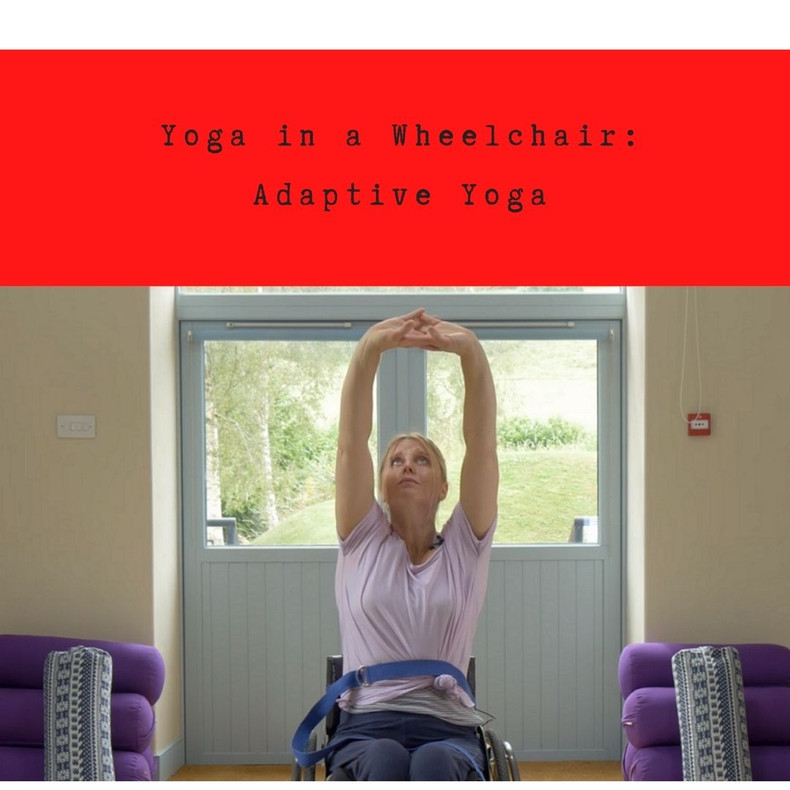I used to go to a yoga studio for courses when I was in my 40s, but I quit because it made me feel "weird." I was working with a yoga instructor to imitate the positions, and I pushed myself to make the poses appear the same as the non-disabled people's. My hip was strained, and I had to rest for several months. That scared me away from yoga, and I never went back. The instructor was not the one who pushed me. It was my desire to appear "normal."
Fortunately, I've given up trying to be like everyone else. I've grown more comfortable with my impairment as I've become older and wiser, and I've stopped comparing myself to others. Simply said, I want to be the healthiest version of myself.
I've recently rekindled my interest in adaptive yoga. As it turns out, I've been doing it for years without even realizing it! Stretching and staying flexible have always been important to me. Sitting for long periods of time produces stiffness and pain, which I alleviate by stretching and practicing deep breathing exercises at home on a daily basis. Getting into certain stances frequently necessitates enlisting the assistance of another individual. You may require more support depending on your unique handicap, but I believe the time and effort are well worth it. Even if that means the most you can do without help is meditation and breathing exercises.
Every one of us should feel confident in our ability to control our own health through exercise. Those of us who use wheelchairs may have to do things a little differently, but we all want to live a better and healthier life.
If you're interested in learning more about adaptive yoga, I highly recommend Dianne Bondy's book Yoga For Everyone. Dianne grew up watching her mother do yoga as a stress-relieving technique. She felt out of place in yoga lessons as an African American lady with a strong build since her body didn't move the same way as the other slim-framed folks. She struggled to pick up stances that her classmates picked up fast. Dianne created strategies to assist people of all shapes, sizes, and abilities participate and feel accepted in the practice of yoga when she became a yoga teacher. She includes a model with Multiple Sclerosis and a double amputee who uses a wheelchair for movement in the book, as well as persons of varied levels of ability practicing variants of each posture. Although the book does not include images of your unique impairment, it does provide wonderful ideas for different stances.
Here are ten poses from the book that I believe are the easiest for paraplegics to adapt, as well as how I personally adapt them.
There are plenty more, but here are a few to get you started:
Happy Baby (Ananda Balasana): This is a pose in which you lie on your back on the floor with your legs drawn up to your chest and your feet in the air. With my arms, I draw my legs up to my chest and secure them. Another option is to wrap a strap over your feet and grip it with your hands.
Easy Pose (Sukhasana): This entails sitting with your feet under you, cross-legged, and your hands on your knees. I bend my legs and place my feet under me with my hands. Then you relax your shoulders and lift your chest. It's possible that people with upper-body impairments will require the assistance of another person to bring their shoulders back.
Child's pose (Supta Balasana): For this one, I got out of my wheelchair and onto the floor. I sit in front of a chair with a blanket on the seat and lean my body against the chair's seat, stacking my forearms on the seat, and resting my head on my forearms.
Cobra (Bhujangasana): For this posture, I lie down on my stomach with my palms on the floor. With my arms completely extended, I then lift my chest off the floor. It is quite beneficial to me in terms of lengthening my front body and strengthening the muscles in my back and upper body. It also gives my hips a nice stretch.
Low Plank (Chaturanga Dandasana): This pose necessitates the use of some additional gear. Under my torso, I use a large oblong bolster, but you could also use extra pillows. My palms are on the floor at my sides, with my stomach towards the floor.
Corpse (Bhujangasana): I lay on my back on the floor in this pose (Bhujangasana). To keep my thighs together, I tie a loose workout band across them. To keep my thighs together, I tie a loose workout band across them.
Hand to Big Toe (Supta Padangusthasana): This is normally done standing up, however I prefer to do it laying down. With the same hand, I lift my leg up to my chest and grab the outer border of my foot.
Head to Knee Forward Fold (Janu Sirasana): I do this on the floor with my legs straight in front of me. I bend forward at the waist toward my toes, wrapping a strap over the ball of my foot and tugging it tight so that my toes point upward.
Wide-Angled Seated Forward Fold (Upavistha Konasana): I lie face down on the floor and stretch my legs out straight at the largest angle possible. Then I lay my hands flat on the mat in front of me and stretch my spine from the crown of my head to the base of my spine.
Wind Relieving (Pawanmuktasana): I lie down on my back with my legs stretched and my arms relaxed by my sides. I then lift my right knee to my chest with my arms. I bring my left leg nearer my chest as I exhale. I occasionally require assistance in bending my leg and bringing it up to my chest.
Dancer (Natarajasana): This posture is normally done standing up, but it may also be done lying down on your stomach with your legs extended on the floor or in a bed. My hands and forearms are close to my head. Someone bends my right knee and hands me my right foot, which I grip at my ankle.
Butterfly (Baddha Konasana): I practice this on the floor, pulling both of my feet in toward my torso. I align my head and back by putting the soles of my feet together and wrapping my hands around my ankles. I bend at the waist, lean forward, and rest my elbows on the sides of my knees while I exhale.
Bow (Dhanurasana): I lie on my stomach and then lift my head slightly off the mat in bow. My pal bends my knees and hands my feet to me one by one. My feet are then held at the ankles. I have someone gently place my feet back on the floor once I finish the pose.
For practicing adaptable yoga poses, I find that having different sized bolsters, blankets, a folding chair, and yoga blocks are beneficial. I can do some of the postures on my own, but others require the assistance of another person. Each person is unique, so you'll have to experiment to determine what works best for you. This is where having a professional yoga instructor can assist you ensure that you are in proper alignment and that you are performing the poses correctly. Matthew Sanford, a paraplegic who operates a non-profit organization called Mind Body Solutions, published a book and a set of CDs that introduced me to adapted yoga.
Their goal is to help people who have been through trauma, bereavement, or handicap reconnect their mind and body.
Matthew, a certified yoga instructor, sees his impairment as a benefit in the practice of yoga since it allows him to focus on the breath.
There are less distractions in this environment. Because he can't feel his legs, he can concentrate on the prana (Vital Life Force) that runs through him. I enjoy hearing that having a disability may be beneficial in yoga practice!
A list of yoga instructors who have completed Mind Body Solutions' adaptive yoga training in each state is one useful resource on the Mind-Body Solutions website. I identified two people in Louisiana and aim to contact them for private instruction as soon as possible. I'm feeling stronger and more balanced as a result of the poses I've been doing lately, and I'm excited to learn more.
Both Dianne Bondy and Matthew Sanford believed they didn't match the stereotype of a typical yoga practitioner. Their physique were dissimilar, which may be intimidating. Despite their early reservations about how they would practice yoga, they have both gone on to become world recognized yoga instructors who have dedicated their careers to educating people about the benefits of yoga. Quadriplegia, amputations, Multiple Sclerosis, Cerebral Palsy, and a variety of other disabilities have all been taught by them. They both teach that any yoga pose may be modified and customized to meet the individual's needs. I'm grateful that their adaptive yoga approaches are now freely accessible to everyone interested in learning more about yoga's physical, mental, and spiritual advantages.
There are a lot of instructors available online. You might even be able to find a local class or private tutor. I found a lot of videos on YouTube that you may watch from the comfort of your own home.
Now go forth and practice adaptive yoga to live your best life!

